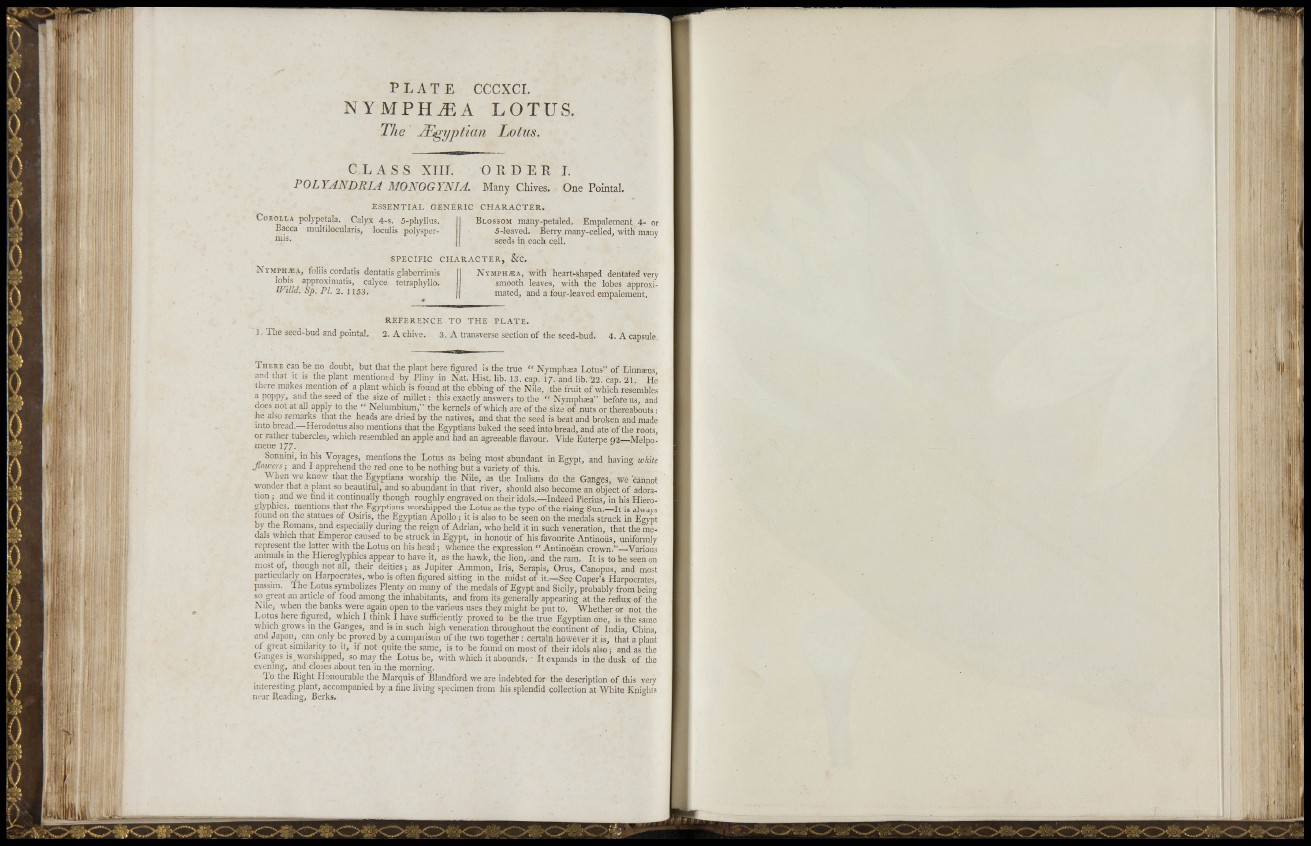
LÌ
I r '
il '
pi'- !
1»
. '-ti
( i . :
! i.
à
jiii f:
I
1'i
j
a '
I" 1> "<i-I1:H i i. ti
r ' i - i
-ii ii,
' H
•'iì'
P L A T E CC C X C I .
N Y M P H T E A LOTUS.
T h e JFigyptian Lotus.
C L A S S XIIL
POLYANDRIA M0N0GYNL4.
E S S E N T I A L GENERIC
COROLLA polypetala. Calyx 4-s. 5-pliyllus.
Eacca multilocularis/ loculis polysperniis.
I.
One Pointai.
O R D E R
Many Chives.
C H A R A C T E R .
BLOSSOM many-petaled. Empalement 4- or
5-leaved. Berry many-celled^ with many
seeds in each cell.
S P E C I F I C CHARACTER,
ÎCYMPH.ÎÎA, foliis cordatis dentatis glaberrimis
lobis approxiniatis, calyce tetraphyllo,
lFiUd.Sp.Pl.2.il53.
&C.
N y m p h j E a , with heart-shaped dentated very
smooth leaves, with the lobes approximated,
and a fom'-leaved empalement.
R E F E R E N C E TO THE PLATE.
1. The seed-bud and pointal. 2. A chive. 3. A ti'ansverse section of the seed-bud. 4. A capsule,
THERE can be no doubt, but tliat tlie plant here figured is the true " Nymphiea Lotus" of Linnaeus
and tnat it is the plant mentiontd by Pliny in Nat. Hist. lib. 13. cap. 17. and lib.'22. cap. 21 He
there makes mention of a plant which is found at tlie ebbing of the Nile, the truit of which resembles
a poppy, and the seed of the size o f millet: tliis exactly answers to the " Nvmphaea" befoie us, and
does not at all apply to the " Nelumbium," the kernels of which are of the siz4 o f nuts or tliereabouts •
he also remarks tliat the heads are dried by the natives, and Uiat the seed is beat and broken and made
into bread.—Herodotus also mentions that the Egyptians baked the seed into bread, and ate of tlie roots
or rather tubercles, which resembled an apple and had an agreeable flavour. Vide Euterpe 02—M e l p o '
mene 177. r f
Sonnini, in his Voyages, mentions the Lotus as being most abundant in Egypt, and having white
Jiotvers; and I apprehend tlie red one to be nothing but a variety of this.
When we know that the Egyptians worship the Nile, as the Indians do the Ganges, we cannot
wonder that a plant so beautilul, and so abundant in tliat river, should also become an object of adoration
j and we tind it continually though roughly engraved on their idols.—Indeed Pierius, in his Hieroglyphics,
mentions tliat the Egyptians worshipped the Lotus as the type of the rising Sun.—I t is always
tound on the statues of Osiris, the Egyptian Apollo; it is also to be seen on the medals struck in Egypt
by the Romans, and especially during tlie reign o f Adrian, who held it in such veneration, that the medais
which th.1t Emperor caused to be struck in Eg)'pt, in honour of his favourite Antinoiis, uniformly
represent the latter with the Lotus on his head ; whence the expression " Antinoean crown."—Various
animals in the Hieroglyphics appear to have it, as the hawk, the lion, and the ram. It is to be seen on
most of, though not all, their deities; as Jupiter Ammon, Iris, Serapis, Orus, Canopus, and most
particularly on Harpocrates, who is often fi.gured sitting in the midst of it.—See Caper's Harpocrates,
passim. Tiie Lotus symbolizes Plenty on many of the medals of Egypt and Sicily, probably from beinc^
so great an article of lood among the inhabitants, and from its generally appearing at the reflux of the
Nile, when the banks were again open to tlie various uses tliey might be put to. Whether or not the
L o t u s here fibred, which I think I have sufficiently proved to be the true Egyptian one, is the same
which grows in the Ganges, and is in such high veneration throughout the continent of India, China,
and Japan, can only be proved by a comparison of the two together : certain however it is, that a plant
ot great similarity to it, if not quite the same, is to be found on most of their idols also ; and as the
Ganges is worshipped, so may the Lotus be, with which it abounds. It expands in the dusk of tlie
evening, and closes about ten in the morning.
T o the Right Honourable the Marquis of Blandford we are indebted for the description of tliis veiy
interesting plant, accompanied by a fine living specimen from his splendid collection at Whi t e Knights
near Reading, Berks, °
H ÏÏmm
i ïif